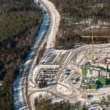The NRC needs its own oversight
By David Lochbaum, June 13, 2008
A common factor that differentiates top performing from underperforming nuclear power plants is the health of their corrective action programs (CAPs). By law, plant owners must have such programs in place that find and fix problems in a timely manner. This regulation recognizes that complex industrial sites such as nuclear plants experience everything from equipment failure to human error. CAPs provide for these realities while protecting against problems, either individually or collectively, that compromise safety margins. Sites with robust programs achieve strong safety performance and minimal operating costs. Sites with ineffective programs experience declining performance and rising operating costs.
The Nuclear Regulatory Commission (NRC) has never had such an internal oversight program even remotely resembling those that it requires of its nuclear sites. And while no rule requires the NRC to have a CAP, there’s also no regulatory impediment to the commission instituting one. Simply put, the NRC must have an effective corrective action program to be an effective regulator.
The NRC’s lack of such a program would solve many of the problems articulated by our discussants. An effective CAP would enhance the training program for NRC personnel that Tony Pietrangelo desires, just as they shape and inform training programs for nuclear plant workers. An effective CAP would provide protection against passively tolerating the waste confidence fiasco at Yucca Mountain that Victor Gilinsky describes in his response. It would also guard against the overzealous and unjustified regulation Andy Kadak decries and the under-zealous, unacceptable regulation that I detail. Effective oversight programs ensure that expectations are met–whether they are to safely operate nuclear power plants or to acceptably regulate them.
It’s not that the NRC never corrects its mistakes. For example, the commission formed task forces after oversight failures at the Davis-Besse nuclear plant in Ohio and the Indian Point plant in New York and implemented dozens of process improvements identified by those investigations. If the NRC had an effective corrective action program, such failures might have been avoided or, at a minimum, the list of retroactive fixes might have been shorter.
Poor performing nuclear plant sites such as Palo Verde in Arizona have ineffective oversight programs. One reason that such programs are ineffective is that the threshold for reporting problems is set too high. When small incidents are kept from CAP review, the potential for connecting the dots of seemingly isolated issues is prevented, and systematic process flaws aren’t corrected until they’re revealed by larger problems. History has repeatedly demonstrated that such high-threshold CAPs cannot sustain the high-safety, low-cost operations that Andy champions.
The NRC essentially functions like a nuclear plant with a very high CAP threshold. Small problems are addressed in isolation with virtually no deeper assessment, root-cause evaluation, or trending analysis. When a regulatory failure triggers a fact-finding investigation, then and only then are such invaluable tools applied.
An effective corrective action program at the NRC wouldn’t silence Victor, Andy, Tony, or myself. But it would refocus our concerns on whether the NRC’s proposed fixes to emerging problems were comprehensive, cost-effective, and sufficiently expeditious. That would be a more meaningful debate than the one we’re having over the depth, breadth, and causes of the NRC’s recurring failures.
Topics: Nuclear Energy
Share: [addthis tool="addthis_inline_share_toolbox"]














